Early Jesus-Devotion: Critical Engagement
by larryhurtado
In a recent comment, Sean Garrigan suggested that I provide pointers to some of the critical engagements that have been offered to my work on early Jesus-devotion, particularly in my book, Lord Jesus Christ: Devotion to Jesus in Earliest Christianity (Eerdmans, 2003). I’m thinking of preparing a fuller discussion for another occasion, so here I’ll simply give the bibliographical information on critiques and any responses from me.
One of the earliest scholars invited to respond to my book was Maurice Casey (Nottingham), an invited review-essay: Maurice Casey, “Lord Jesus Christ: A Response to Professor Hurtado,” Journal for the Study of the New Testament 27, no. 1 (2004): 83-96. I was invited to give a response, which appeared in the same issue of the journal: Larry W. Hurtado, “Devotion to Jesus and Historical Investigation: A Grateful, Clarifying and Critical Response to Professor Casey,” JSNT 27, no. 1 (2004): 97-104.
Responding earlier, mainly to my book One God, One Lord: Early Christian Devotion and Ancient Jewish Monotheism (Fortress, 1988; T&T Clark, 1998), Adela Yarbro Collins, “The Worship of Jesus and the Imperial Cult,” in The Jewish Roots of Christological Monotheism: Papers From the St. Andrews Conference on Teh Historical Origins of the Worship of Jesus, ed. Carey C. Newman, James R. Davila and Gladys S. Lewis (Leiden: Brill, 1999), 234-57. In her contribution to the Festschrift for Alan Segal and me, she entered a later critical response to my work: Adela Yarbro Collins, “‘How on Earth Did Jesus Become a God?’: A Reply,” in Israel’s God and Rebecca’s Children: Christology and Community in Early Judaism and Christianity, ed. David B. Capes et al. (Waco: Baylor University Press, 2007), 55-66. Essentially, Collins urges that ruler-worship may have been more of a factor than I judge. She grants that direct influence is most unlikely among devout Jews (such as those who made up the earliest circles of Jesus-followers), but proposes that perhaps there was some kind of unconscious influence, unreflectively disposing some devout Jews to accommodate the worship of Jesus alongside God.
I’m not persuaded. As I haven’t responded in print to Collins specifically, I’ll give a brief comment here. If pagan ruler-cult influence was as subtly influential on devout Jews as she suggests, shouldn’t we see more than one example of its alleged influence? Why is it that the “high” Jesus-devotion that we see erupted in the earliest circles of Jesus-followers seems to have no true analogy or parallel in the time? In fact, we know very well what devout Jews of the time thought of pagan ruler-cult and the deification of human heroes, and it’s not encouraging for a theory of the origins of Jesus-devotion!
The longest critical engagement that I know of, however, was this one: Crispin Fletcher-Louis, “A New Explanation of Christological Origins: A Review of the Work of Larry W. Hurtado.” Tyndale Bulletin 60, no. 2 (2009): 161-205. Again, I was invited to respond by the journal editor: L. W. Hurtado, “The Origins of Jesus-Devotion: A Response to Crispin Fletcher-Louis,” Tyndale Bulletin 61, no. 1 (2010): 1-20.
I’ve also commented on some alternative approaches in How on Earth did Jesus Become A God? (eerdmans, 2005), in the chapter entitled, “How on Earth Did Jesus Become a God? Approaches to Jesus-Devotion in Earliest Christianity,” pp. 13-30.
As I see things, here are the major findings that (with a number of others) I advocate:
1) A robust Jesus-devotion, in which Jesus was accorded unique status as agent of God’s purposes, and (most remarkably) became central in the devotional life of believers, erupted quickly and early. It’s beginnings are likely within the first months, certainly the first year or two, after Jesus’ execution.
2) The most notable and distinctive feature of this Jesus-devotion was the programmatic place and centrality of Jesus in the devotional/cultic practices of believers. In the Roman historical context, this remarkable mutation in Jewish devotional practice is in fact more noteworthy and significant than the rich and impressive christological beliefs that characterized earliest circles of Jesus-believers.
3) This “dyadic” devotional pattern (Jesus included with God as recipient of devotion) is without real precedent or analogy in its time. It constitutes a novel “mutation” in Jewish devotional practice. From as early as my 1988 book (One God, One Lord), I have specified the particulars of this devotional pattern (pp. 99-114), and a refutation of my position will require demonstration of similar devotional specifics in contemporary (or prior) circles of devout Jews. None has been provided to this date.
4) In its initial stages, this intense Jesus-devotion and the movement that promoted it comprise a distinctive development within the diverse second-temple Jewish tradition. There are obvious connections and also distinctives that mark the early Jesus-movement.












